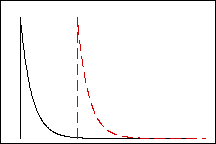
Most often used to model the behavior of units that have a constant failure rate. The exponential distribution has a wide range of applications in analyzing the reliability and availability of electronic systems, queuing theory, and Markov chains. For example, the time to failure of electronic components, the time between customers' arrivals at a terminal, time for radioactive nucleus decay, or the distance a photon travels in a medium before colliding with dust particles.
An important property of the exponential distribution is that it is memoryless. The memoryless property indicates that the remaining life of a component is independent of its current age. For example, a system that experiences wear and tear and therefore becomes more likely to fail later in its life is not memoryless.
The 1-parameter exponential distribution is described by its scale parameter. The 2-parameter exponential distribution is described by its scale and threshold parameters. The threshold parameter, l , if positive, shifts the beginning of the distribution by a distance l to the right. For example, you are interested in studying the failure of a system with l = 5. This means that the failures start to occur only after 5 hours of operation and cannot occur before.
